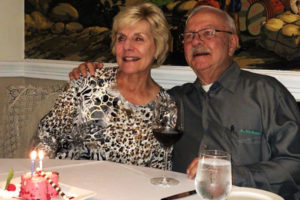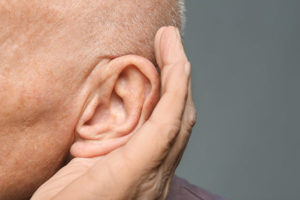Imagine normal.
Everyone around you moves as they should. Everything sounds fine. You fit right in.
但是你不喜欢。
在现实中,你行动缓慢。当你说话时,你旁边的人会紧张地听。但你不知道。
This is the dilemma of people withParkinson’s disease, where signals from your brain to your muscles grow progressively weaker. Your brain orders a big step or a loud, clear sentence, but your leg translates the step as a shuffle, your vocal cords respond with a whisper – and you have no idea.
Therapies help manage Parkinson’s
帕金森氏症没有治愈方法。But thanks to therapies like LSVT BIG® and LSVT LOUD®, offered byOSF Rehabilitation, symptoms can be managed.
“If we didn’t have programs like those, I don’t know what we would have done,” Gladys Schmidt said.
 John, her husband of 52 years, has Parkinson’s. Gladys first started to notice changes in his gait and speech a few years ago, but didn’t give them too much thought because episodes were intermittent. Then their adult sons noted John’s slurred speech when talking on the phone. To John, though, everything felt normal. Almost.
John, her husband of 52 years, has Parkinson’s. Gladys first started to notice changes in his gait and speech a few years ago, but didn’t give them too much thought because episodes were intermittent. Then their adult sons noted John’s slurred speech when talking on the phone. To John, though, everything felt normal. Almost.
“I fell once or twice, but I just thought I was getting older, or something had tripped me that I didn’t notice,” John said. “But I knew something wasn’t right.”
For a year, his doctor had been ordering tests, which John passed with flying colors. Then, while sitting in his hotel room on a business trip in October 2015, John couldn’t decipher a single word of the notes he had taken that day.
约翰的医生把他送到神经科医生那里做更多的检查。一年后,他终于被诊断出患有帕金森氏症。
约翰说:“知道这是怎么回事,其实是一种解脱。”“既然我知道问题出在哪里,我想我可以做点什么。”
Big movement, loud speech
Lee Silverman Voice Treatment (LSVT) BIG and LOUD are named for a woman with Parkinson’s who inspired her therapist to do research that led to the program’s founding in the 1980s. LSVT LOUD was the first evidence-based therapy that proved to make a long-term difference in the lives of Parkinson’s patients. LSVT BIG soon followed.
LSVT BIG addresses movement, while LSVT LOUD deals withspeech.
“The programs are designed to help the person understand that in their head, they feel like they are moving and talking normal, but what the rest of us see and hear is not normal,” said Brittany Heidemann, MS, CCC-SLP, a speech language pathologist atOSF Rehabilitation in Peoria.
When a person with Parkinson’s is referred to OSF Rehabilitation, they undergo an evaluation that includes audio-visual recordings of their words and actions.
“Usually at first, they’re in denial,” Brittany said. “But then we let them watch themselves, and they go, ‘Oh, you’re kidding me. That’s what I look like? That’s why people tell me they can’t hear me?’”
Recalibrating normal
Therapists work with their patients to set personalized goals. Those goals vary, depending on the individual, and they may be as simple as being able to play on the floor with a grandchild. Other goals are more standardized, such as maintaining a speaking volume of 85-90 decibels.
The approaches to therapy are consistent.
“We push big and loud,” said Mike Holloway, PT, DPT, a physical therapist at OSF Rehabilitation. “If you exaggerate and go bigger, you will end up at normal. We just have to recalibrate what sounds and feels normal to them.”

这些课程都是高强度的,每个课程要求每周进行四次,每次一小时,持续四周。
LSVT BIG从相对简单的活动开始,比如下床或上下楼梯。职业治疗师将处理病人的手和手臂,处理在穿衣服或做饭时有用的精细运动技能。理疗师将致力于发展和保持腿部力量、平衡和行走。
An LSVT LOUD session includes a series of voice stretching exercises, each repeated 15 times, and working on everyday phrases like, “Is the mail here yet?” There are also practical application exercises, such as conversing with OSF Rehabilitation staff.
An alternative program to LSVT LOUD is SPEAK OUT!®, which starts with individual therapy and advances to The LOUD Crowd®, a weekly group session. SPEAK OUT! also includes components that address memory issues and finding the right word to use, as Parkinson’s also slows down that process.
所有的项目都伴随着30天的家庭作业,让患者自己完成。
Rehab program saves his speech
John Schmidt has been through all of the programs.
“I started with LOUD. It did feel like I was shouting, but I started talking better. I could tell,” John said. “The problem is that once you finish the therapy, you’re on your own to keep up with the exercises. I did not, and my voice again deteriorated.”
布列塔尼推荐了《说出来!》节目,约翰现在参加了大声喧哗的人群。
“我真的相信,如果没有这个项目,我就不会用我的声音交流,”约翰说。
“Later, I did the LSVT BIG. I really like the exercises. I have been engaged in a program calledRock Steady Boxing, which is great. The strength that I had gained really has helped me. The BIG program helped me focus on exercises that helped my balance. I feel a lot better.”
Click hereto learn more about neurological rehabilitation programs at OSF HealthCare.
